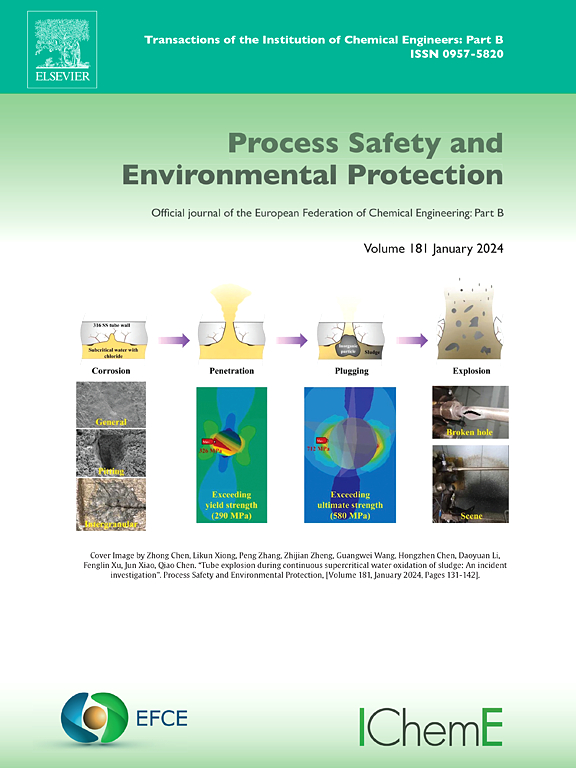基于BP神经网络和卷积神经网络的海底管道溢油面积预测模型
IF 6.9
2区 环境科学与生态学
Q1 ENGINEERING, CHEMICAL
引用次数: 0
摘要
近年来,对石油资源的需求不断增长。海洋石油运输和勘探的日益发展也带来了海洋溢油问题。溢油预测模型可用于预测溢油的扩散行为,是溢油事故风险评估的重要工具。因此,通过计算0.5 ~ 7 s内不同水深(静水)、泄漏孔径、海面风速和0#柴油管道流量下的溢油面积,共生成686组溢油面积数据。采用BP神经网络、遗传算法优化BP神经网络、粒子群优化BP神经网络和卷积神经网络4种算法对海底管道溢油区域进行预测,建立了海底管道溢油区域预测模型。以水深、泄漏孔径、海面风速、管道流速等影响因素作为模型输入,输出为预测结果。通过对比BP、PSO-BP、GA-BP和CNN的训练和验证结果,发现pso改进的BP神经网络预测模型对海底管道溢油区域的预测精度更高。与普通BP神经网络相比,测试集的RMSE降低了54 %,MAE降低了50.22 %,基本满足了实际应用标准。确定PSO-BP神经网络在油膜溢油区域预测中具有较好的收敛性和准确性,因此PSO-BP神经网络模型可用于溢油区域预测,为溢油事故的可靠预测提供理论依据和技术支持。本文章由计算机程序翻译,如有差异,请以英文原文为准。
Oil spill area prediction model of submarine pipeline based on BP neural network and convolutional neural network
In recent years, there has been a growing demand for oil resources. The increasing development of marine oil transport and exploration also brings the problem of marine oil spill. Oil spill prediction models can be used to predict the spreading behaviour of oil spills, which is an important tool for risk assessment during oil spill accidents. Therefore, by calculating the oil spill area under different water depth (static water), leakage aperture, sea surface wind speed and 0# diesel pipeline flow rate within 0.5–7 s, a total of 686 sets of oil spill area data were generated. Four algorithms, namely BP neural network, genetic algorithm-optimized BP neural network, particle swarm optimization BP neural network and convolutional neural network, were employed to predict the oil spill area, and a prediction model for the oil spill area of submarine pipelines was established. The influencing factors such as water depth, leakage aperture, sea surface wind speed and pipeline flow velocity were used as model inputs, and the output was the prediction result. By comparing the training and validation results of BP,PSO-BP,GA-BP and CNN, it was found that the PSO-improved BP neural network prediction model had a higher prediction accuracy for the oil spill area of submarine pipelines. Compared with the ordinary BP neural network, the RMSE of the test set was reduced by 54 %, and the MAE was reduced by 50.22 %, which basically met the practical application standards. It is determined that the PSO-BP neural network embodies better convergence and accuracy in oil spill area prediction of oil film, so the PSO-BP neural network model can be used as the prediction of oil spill area, which can provide the theoretical basis and technical support for the reliable prediction of oil spill accidents.
求助全文
通过发布文献求助,成功后即可免费获取论文全文。
去求助
来源期刊

Process Safety and Environmental Protection
环境科学-工程:化工
CiteScore
11.40
自引率
15.40%
发文量
929
审稿时长
8.0 months
期刊介绍:
The Process Safety and Environmental Protection (PSEP) journal is a leading international publication that focuses on the publication of high-quality, original research papers in the field of engineering, specifically those related to the safety of industrial processes and environmental protection. The journal encourages submissions that present new developments in safety and environmental aspects, particularly those that show how research findings can be applied in process engineering design and practice.
PSEP is particularly interested in research that brings fresh perspectives to established engineering principles, identifies unsolved problems, or suggests directions for future research. The journal also values contributions that push the boundaries of traditional engineering and welcomes multidisciplinary papers.
PSEP's articles are abstracted and indexed by a range of databases and services, which helps to ensure that the journal's research is accessible and recognized in the academic and professional communities. These databases include ANTE, Chemical Abstracts, Chemical Hazards in Industry, Current Contents, Elsevier Engineering Information database, Pascal Francis, Web of Science, Scopus, Engineering Information Database EnCompass LIT (Elsevier), and INSPEC. This wide coverage facilitates the dissemination of the journal's content to a global audience interested in process safety and environmental engineering.
 求助内容:
求助内容: 应助结果提醒方式:
应助结果提醒方式:


